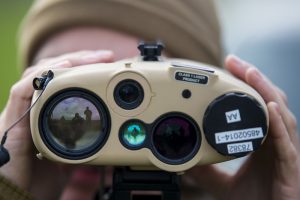
As a means of aiding personnel in locating battlefield adversaries, Marine Corps officials said the branch is incorporating new technologies into existing handheld GPS targeting systems.
The Common Laser Range Finder-Integrated Capability (CLRF-IC), which officials said was fielded two years ago, is a handheld target location system using an eye-safe laser range finder and algorithms to determine a target’s location.
The Marine Corps Systems Command’s (MCSC) Ground Combat Element Systems began an in-production engineering change proposal (ECP) process to incorporate an enhanced digital magnetic capability into the CLRF-IC. The change would
reduce the amount of time and movement required by Marines when using the system.
“Previously, the magnetic effects of an environment would cause the operator to go through a series of sitting and standing, stepping to the left and to the right in order to calibrate the system,” Jeff Nebel, MCSC’s Fire Support Coordination team lead, said. “What we’re integrating is a new digital magnetic compass so the operator can calibrate the system basically the same way you do your cellphone—just rotate it left to right, and up and down a few times.”
Officials anticipate the first enhanced devices are slated to field later this year and Nebel projects the system will reach Full Operational Capability by early 2021.
“Most of the Marines like how light the system is,” he said. “It’s significantly lighter than the previous system.
Paul Knight, the lead systems engineer for the CLRF-IC, said a lighter system reduces the amount of weight the Marine Air-Ground Task Force must carry on the battlefield, enabling personnel to transport additional gear if necessary.




